Water Availability for Cannabis in Northern California: Intersections of Climate, Policy, and Public Discourse
Abstract
1. Introduction
2. Materials and Methods
2.1. Study Area
2.2. Determining the Climate-Water Relationship
2.2.1. Data
2.2.2. Analysis
2.3. Assessing Current Water Policy
2.3.1. Data
2.3.2. Analysis
2.4. Exploring Public Discourse Through Media Coverage
2.4.1. Data
2.4.2. Analysis
3. Results
3.1. The Climate-Water Relationship
3.2. Implications of Current Water Policy
4. Discussion
Limitations and Future Work
5. Conclusions
Supplementary Materials
Author Contributions
Funding
Data Availability Statement
Acknowledgments
Conflicts of Interest
References
- Boelens, R.; Hoogesteger, J.; Swyngedouw, E.; Vos, J.; Wester, P. Hydrosocial territories: A political ecology perspective. Water Int. 2016, 41, 1–14. [Google Scholar] [CrossRef]
- Linton, J.; Budds, J. The hydrosocial cycle: Defining and mobilizing a relational-dialectical approach to water. Geoforum 2014, 57, 170–180. [Google Scholar] [CrossRef]
- Graham, N.T.; Hejazi, M.I.; Chen, M.; Davies, E.G.R.; Edmonds, J.A.; Kim, S.H.; Turner, S.W.D.; Li, X.; Vernon, C.R.; Calvin, K.; et al. Humans drive future water scarcity changes across all Shared Socioeconomic Pathways. Env. Res. Lett. 2020, 15, 014007. [Google Scholar] [CrossRef]
- Haddeland, I.; Heinke, J.; Biemans, H.; Eisner, S.; Flörke, M.; Hanasaki, N.; Konzmann, M.; Ludwig, F.; Masaki, Y.; Schewe, J.; et al. Global water resources affected by human interventions and climate change. Proc. Natl. Acad. Sci. USA 2014, 111, 3251–3256. [Google Scholar] [CrossRef] [PubMed]
- Veldkamp, T.I.E.; Wada, Y.; Aerts, J.C.J.H.; Ward, P.J. Towards a global water scarcity risk assessment framework: Incorporation of probability distributions and hydro-climatic variability. Env. Res. Lett. 2016, 11, 024006. [Google Scholar] [CrossRef]
- Schewe, J.; Heinke, J.; Gerten, D.; Haddeland, I.; Arnell, N.W.; Clark, D.B.; Dankers, R.; Eisner, S.; Fekete, B.M.; Colón-González, F.J.; et al. Multimodel assessment of water scarcity under climate change. Proc. Natl. Acad. Sci. USA 2014, 111, 3245–3250. [Google Scholar] [CrossRef]
- Fant, C.; Schlosser, C.A.; Gao, X.; Strzepek, K.; Reilly, J. Projections of Water Stress Based on an Ensemble of Socioeconomic Growth and Climate Change Scenarios: A Case Study in Asia. PLoS ONE 2016, 11, e0150633. [Google Scholar] [CrossRef]
- Gollehon, N.; Quinby, W. Irrigation in the American West: Area, Water and Economic Activity. Int. J. Water Resour. Dev. 2000, 16, 187–195. [Google Scholar] [CrossRef]
- Johnston, W. Cross Sections of a Diverse Agriculture: Profiles of California’s Agricultural Production Regions and Principal Commodities; Giannini Foundation, University of California: Davis, CA, USA, 2003. [Google Scholar]
- Cooley, H.; Gleick, P.; Wilkinson, R. Agricultural Water Conservation and Efficiency Potential in California; National Resource Defense Council: San Francisco, CA, USA, 2014; p. 8. [Google Scholar]
- Owen, D. California groundwater management, science-policy interfaces, and the legacies of artificial legal distinctions. Env. Res. Lett. 2019, 14, 12. [Google Scholar] [CrossRef]
- State Water Resources Control Board. A Guide to California Water Rights Appropriations; California Environmental Protection Agency, Division of Water Rights: Sacramento, CA, USA, 2000; p. 34. [Google Scholar]
- Wilson, T.S.; Sleeter, B.M.; Cameron, D.R. Mediterranean California’s water use future under multiple scenarios of developed and agricultural land use change. PLoS ONE 2017, 12, e0187181. [Google Scholar] [CrossRef]
- Hossack, J. Leading the way in sustainable practices: How the cannabis cultivation policy is rethinking water management in California. Hastings Environ. Law J. 2019, 25, 21. [Google Scholar]
- State Water Resources Control Board. Cannabis Cultivation Policy: Principles and Guidelines for Cannabis Cultivation; State Water Resources Control Board, State of California: Sacramento, CA, USA, 2019; p. 117. [Google Scholar]
- Bauer, S.; Olson, J.; Cockrill, A.; van Hattem, M.; Miller, L.; Tauzer, M.; Leppig, G. Impacts of surface water diversions for marijuana cultivation on aquatic habitat in four northwestern California watersheds. PLoS ONE 2015, 10, e0120016. [Google Scholar] [CrossRef]
- Butsic, V.; Carah, J.K.; Baumann, M.; Stephens, C.; Brenner, J.C. The emergence of cannabis agriculture frontiers as environmental threats. Env. Res. Lett. 2018, 13, 124017. [Google Scholar] [CrossRef]
- Short Gianotti, A.G.; Harrower, J.; Baird, G.; Sepaniak, S. The quasi-legal challenge: Assessing and governing the environmental impacts of cannabis cultivation in the North Coastal Basin of California. Land Use Policy 2017, 61, 126–134. [Google Scholar] [CrossRef]
- Gabriel, M.W.; Wengert, G.M.; Higley, J.M.; Krogan, S.; Sargent, W.; Clifford, D.L. Rodenticides on Illegal Marijuana Crops Harm Wildlife. Wildl. Prof. 2013, 5, 46–50. [Google Scholar]
- Thompson, C.; Sweitzer, R.; Gabriel, M.; Purcell, K.; Barrett, R.; Poppenga, R. Impacts of Rodenticide and Insecticide Toxicants from Marijuana Cultivation Sites on Fisher Survival Rates in the Sierra National Forest, California: Impacts of toxicants on fisher survival. Conserv. Lett. 2014, 7, 91–102. [Google Scholar] [CrossRef]
- Franklin, A.B.; Carlson, P.C.; Rex, A.; Rockweit, J.T.; Garza, D.; Culhane, E.; Volker, S.F.; Dusek, R.J.; Shearn-Bochsler, V.I.; Gabriel, M.W.; et al. Grass is not always greener: Rodenticide exposure of a threatened species near marijuana growing operations. BMC Res. Notes 2018, 11, 94. [Google Scholar] [CrossRef]
- Stoa, R.B. Comparative Cannabis: Approaches to Marijuana Agriculture Regulation in the United States and Canada. Univ. Pac. Law Rev. 2017, 49, 29. [Google Scholar]
- Dettinger, M. Climate change, atmospheric rivers, and floods in California: A multimodel analysis of storm frequency and magnitude changes. J. Am. Water Resour. Assoc. 2011, 47, 514–523. [Google Scholar] [CrossRef]
- Dillis, C.; Grantham, T.E.; McIntee, C.; McFadin, B.; Grady, K. Watering the Emerald Triangle: Irrigation sources used by cannabis cultivators in Northern California. Calif. Agr. 2019, 73, 146–153. [Google Scholar] [CrossRef]
- Griffin, D.; Anchukaitis, K.J. How unusual is the 2012-2014 California drought? Geophys. Res. Lett. 2014, 41, 9017–9023. [Google Scholar] [CrossRef]
- Yoon, J.-H.; Wang, S.-Y.S.; Gillies, R.R.; Kravitz, B.; Hipps, L.; Rasch, P.J. Increasing water cycle extremes in California and in relation to ENSO cycle under global warming. Nat. Commun. 2015, 6, 8657. [Google Scholar] [CrossRef] [PubMed]
- O’Brien, J.P.; O’Brien, T.A.; Patricola, C.M.; Wang, S.-Y.S. Metrics for understanding large-scale controls of multivariate temperature and precipitation variability. Clim. Dyn. 2019, 53, 3805–3823. [Google Scholar] [CrossRef]
- Guirguis, K.; Gershunov, A.; Shulgina, T.; Clemesha, R.E.S.; Ralph, F.M. Atmospheric rivers impacting Northern California and their modulation by a variable climate. Clim. Dyn. 2019, 52, 6569–6583. [Google Scholar] [CrossRef]
- Swain, D.L.; Tsiang, M.; Haugen, M.; Singh, D.; Charland, A.; Rajaratnam, B.; Diffenbaugh, N.S. The extraordinary California drought of 2013/2014: Character, context, and the role of climate change. BAMS 2014, 2014, 17. [Google Scholar]
- Gershunov, A.; Shulgina, T.; Ralph, F.M.; Lavers, D.A.; Rutz, J.J. Assessing the climate-scale variability of atmospheric rivers affecting western North America: Atmospheric River Climate-Scale Behavior. Geophys. Res. Lett. 2017, 44, 7900–7908. [Google Scholar] [CrossRef]
- Bodwitch, H.; Carah, J.; Daane, K.M.; Getz, C.; Grantham, T.E.; Hickey, G.M.; Wilson, H. Growers say cannabis legalization excludes small growers, supports illicit markets, undermines local economies. Calif. Agr. 2019, 73, 177–184. [Google Scholar] [CrossRef]
- Polson, M. Making marijuana an environmental issue: Prohibition, pollution, and policy. Environ. Plan. E Nat. Space 2019, 2, 229–251. [Google Scholar] [CrossRef]
- Corva, D. Requiem for a CAMP: The life and death of a domestic U.S. drug war institution. Int. J. Drug Policy 2014, 25, 71–80. [Google Scholar] [CrossRef]
- Hall, W.; Lynskey, M. Evaluating the public health impacts of legalizing recreational cannabis use in the United States: Impacts of legalizing recreational cannabis use. Addiction 2016, 111, 1764–1773. [Google Scholar] [CrossRef]
- LaChance, J.C. “We can’t just be a county that supports inebriants”: Voices of the noncannabis agricultural community. Calif. Agr. 2019, 73, 169–176. [Google Scholar] [CrossRef]
- Valachovic, Y.; Quinn-Davidson, L.; Stackhouse, J.; Butsic, V. Perceptions of cannabis among Humboldt County timberland and ranchland owners. Calif. Agr. 2019, 73, 161–168. [Google Scholar] [CrossRef]
- Polson, M.; Petersen-Rockney, M. Cannabis farmers or criminals? Enforcement-first approaches fuel disparity and hinder regulation. Calif. Agr. 2019, 73, 185–193. [Google Scholar] [CrossRef]
- Nelson, K.S.; Burchfield, E.K. Effects of the Structure of Water Rights on Agricultural Production During Drought: A Spatiotemporal Analysis of California’s Central Valley. Water Resour. Res. 2017, 53, 8293–8309. [Google Scholar] [CrossRef]
- DuMars, T.; Minnis, M. New Mexico Water Law: Determining Public Welfare Values in Water Rights Allocation. Ariz. Law Rev. 1989, 31, 25. [Google Scholar]
- Pahl-Wostl, C.; Tàbara, D.; Bouwen, R.; Craps, M.; Dewulf, A.; Mostert, E.; Ridder, D.; Taillieu, T. The importance of social learning and culture for sustainable water management. Ecol. Econ. 2008, 64, 484–495. [Google Scholar] [CrossRef]
- Finn, M.; Jackson, S. Protecting Indigenous Values in Water Management: A Challenge to Conventional Environmental Flow Assessments. Ecosystems 2011, 14, 1232–1248. [Google Scholar] [CrossRef]
- Grant, D.L. Two models of public interest review of water allocation in the west. Water Law Rev. 2006, 9, 35. [Google Scholar]
- Swyngedouw, E. The Political Economy and Political Ecology of the Hydro-Social Cycle. J. Contemp. Water Res. Educ. 2009, 142, 56–60. [Google Scholar] [CrossRef]
- McDaniels, T.L.; Axelrod, L.J.; Cavanagh, N.S.; Slovic, P. Perception of Ecological Risk to Water Environments. Risk Anal. 1997, 17, 341–352. [Google Scholar] [CrossRef]
- Candidi, L. Informal Communities and Cannabis Regulation in the Emerald Triangle. In Governance Beyond the Law; International Political Economy Series; Palgrave Macmillan: London, UK, 2019; Volume 1, pp. 267–289. [Google Scholar]
- Rasmusson, E.M.; Wang, X.; Ropelewski, C.F. The biennial component of ENSO variability. J. Mar. Syst. 1990, 1, 71–96. [Google Scholar] [CrossRef]
- Dettinger, M.D.; Cayan, D.R.; Diaz, H.F.; Meko, D.M. North–South Precipitation Patterns in Western North America on Interannual-to-Decadal Timescales. J. Clim. 1998, 11, 17. [Google Scholar] [CrossRef]
- Barlow, M.; Nigam, S.; Berbery, E.H. ENSO, Pacific Decadal Variability, and U.S. Summertime Precipitation, Drought, and Stream Flow. J. Clim. 2001, 14, 24. [Google Scholar] [CrossRef]
- Gershunov, A.; Shulgina, T.; Clemesha, R.E.S.; Guirguis, K.; Pierce, D.W.; Dettinger, M.D.; Lavers, D.A.; Cayan, D.R.; Polade, S.D.; Kalansky, J.; et al. Precipitation regime change in Western North America: The role of Atmospheric Rivers. Sci. Rep. 2019, 9, 9944. [Google Scholar] [CrossRef]
- Payne, A.E.; Magnusdottir, G. Dynamics of Landfalling Atmospheric Rivers over the North Pacific in 30 Years of MERRA Reanalysis. J. Clim. 2014, 27, 7133–7150. [Google Scholar] [CrossRef]
- Guan, B.; Waliser, D.E. Detection of atmospheric rivers: Evaluation and application of an algorithm for global studies: Detection of Atmospheric Rivers. J. Geophys. Res. Atmos. 2015, 120, 12514–12535. [Google Scholar] [CrossRef]
- Shields, C.A.; Rutz, J.J.; Leung, L.-Y.; Ralph, F.M.; Wehner, M.; Kawzenuk, B.; Lora, J.M.; McClenny, E.; Osborne, T.; Payne, A.E.; et al. Atmospheric River Tracking Method Intercomparison Project (ARTMIP): Project goals and experimental design. Geosci. Model. Dev. 2018, 11, 2455–2474. [Google Scholar] [CrossRef]
- Kalnay, E.; Kanamitsu, M.; Kistler, R.; Collins, W.; Deaven, D.; Gandin, L.; Iredell, M.; Saha, S.; White, G.; Woollen, J.; et al. The NCEP/NCAR 40-Year Reanalysis Project. Bull. Am. Meteorol. Soc. 1996, 77, 437–471. [Google Scholar] [CrossRef]
- Adler, R.F.; Huffman, G.J.; Chang, A.; Ferraro, R.; Xie, P.-P.; Janowiak, J.; Rudolf, B.; Schneider, U.; Curtis, S.; Bolvin, D.; et al. The Version-2 Global Precipitation Climatology Project (GPCP) Monthly Precipitation Analysis (1979–Present). J. Hydrometeorol. 2003, 4, 21. [Google Scholar] [CrossRef]
- Fan, Y.; van den Dool, H. Climate Prediction Center global monthly soil moisture data set at 0.5° resolution for 1948 to present. J. Geophys. Res. 2004, 109, 8. [Google Scholar] [CrossRef]
- De Cicco, L.A.; Lorenz, D.; Hirsch, R.M.; Watkins, W. dataRetrieval: R Packages for Discovering and Retrieving Water Data Available from U.S. Federal Hydrologic Web Services; U.S. Geological Survey: Reston, VA, USA, 2018.
- Murakami, M. Large-Scale Aspects of Deep Convective Activity over the GATE Area. Mon. Weather Rev. 1979, 107, 994–1012. [Google Scholar] [CrossRef]
- Mooney, H.A.; Zavaleta, E. (Eds.) Ecosystems of California; University of California Press: Oakland, CA, USA, 2016; ISBN 978-0-520-27880-6. [Google Scholar]
- Tessman, S.A. Environmental Use Sector: Reconnaissance Elements of the Western Dakotas Region. of South. Dakota Study; Water Resources Institute, South Dakota State Univ: Brookings, SD, USA, 1979. [Google Scholar]
- Dillis, C.; McIntee, C.; Butsic, V.; Le, L.; Grady, K.; Grantham, T. Water storage and irrigation practices for cannabis drive seasonal patterns of water extraction and use in Northern California. J. Environ. Manag. 2020, 272, 110955. [Google Scholar] [CrossRef] [PubMed]
- Division of Water Rights. eWRIMS—Electronic Water Rights Information Management System; State Water Resources Control Board: Sacramento, CA, USA, 2020. [Google Scholar]
- Hashimoto, T.; Stedinger, J.R.; Loucks, D.P. Reliability, resiliency, and vulnerability criteria for water resource system performance evaluation. Water Resour. Res. 1982, 18, 14–20. [Google Scholar] [CrossRef]
- Sandoval-Solis, S.; McKinney, D.C.; Loucks, D.P. Sustainability Index for Water Resources Planning and Management. J. Water Resour. Plann. Manag. 2011, 137, 381–390. [Google Scholar] [CrossRef]
- Wilson, H.; Bodwitch, H.; Carah, J.; Daane, K.; Getz, C.; Grantham, T.E.; Butsic, V. First known survey of cannabis production practices in California. Calif. Agr. 2019, 73, 119–127. [Google Scholar] [CrossRef]
- Elo, S.; Kyngäs, H. The qualitative content analysis process. J. Adv. Nurs 2008, 62, 107–115. [Google Scholar] [CrossRef]
- Gagnon, M.; Gudiño, D.; Guta, A.; Strike, C. What Can we Learn from the English-Language Media Coverage of Cannabis Legalization in Canada? Subst. Use Misuse 2020, 1–4. [Google Scholar] [CrossRef]
- Corbett, J.B. Communicating Nature: How We Create and Understand Environmental Messages; Island Press: London, UK, 2006. [Google Scholar]
- Fabra-Crespo, M.; Rojas-Briales, E. Analysis of mass media news on forest issues: A case study of Spain. For. Syst 2015, 24, e029. [Google Scholar] [CrossRef]
- McCombs, M.E.; Shaw, D.L.; Weaver, D.H. New Directions in Agenda-Setting Theory and Research. Mass Commun. Soc. 2014, 17, 781–802. [Google Scholar] [CrossRef]
- McCombs, M.E.; Shaw, D.L. The Agenda-Setting Function of Mass Media. Public Opin. Q. 1972, 36, 176–187. [Google Scholar] [CrossRef]
- Cockerill, K. Testing Language: Media Language Influence on Public Attitudes About River Management. Appl. Environ. Educ. Commun. 2003, 2, 23–37. [Google Scholar]
- Flint, C.G.; Wynn, E.; Paveglio, T.; Boyd, A.; Bullock, C. Variations in Newspaper Coverage on Water in the U.S. Intermountain West. J. Am. Water Resour Assoc. 2019, 55, 1306–1322. [Google Scholar] [CrossRef]
- Scheufele, D.A.; Tewksbury, D. Framing, Agenda Setting, and Priming: The Evolution of Three Media Effects Models: Models of Media Effects. J. Commun. 2007, 57, 9–20. [Google Scholar] [CrossRef]
- Schmid, A.N.; Thompson, J.R.; Bengston, D.N. The Public Discourse About Land Use and Water Quality: Themes in Newspapers in the Upper Mississippi River Basin. Appl. Environ. Educ. Commun. 2007, 6, 187–196. [Google Scholar] [CrossRef]
- Kim, H.; Kim, S.-H. Framing marijuana: How U.S. newspapers frame marijuana legalization stories (1995–2014). Prev. Med. Rep. 2018, 11, 196–201. [Google Scholar] [CrossRef] [PubMed]
- Bernacchi, L.A.; Fernandez-Bou, A.S.; Viers, J.H.; Valero-Fandino, J.; Medellín-Azuara, J. A glass half empty: Limited voices, limited groundwater security for California. Sci. Total Environ. 2020, 738, 139529. [Google Scholar] [CrossRef] [PubMed]
- de Loë, R.C. Dam the news: Newspapers and the Oldman River Dam project in Alberta. J. Environ. Manag. 1999, 55, 219–237. [Google Scholar] [CrossRef]
- Spurgeon, S.L. Miracles in the Desert: Literature, Water, and Public Discourse in the American West. Interdiscip. Stud. Lit. Environ. 2009, 16, 743–759. [Google Scholar] [CrossRef]
- Quesnel, K.J.; Ajami, N.K. Changes in water consumption linked to heavy news media coverage of extreme climatic events. Sci. Adv. 2017, 3, e1700784. [Google Scholar] [CrossRef]
- Saldana, J. An introduction to codes and coding. In The Coding Manual for Qualitative Researchers; SAGE Publications: London, UK, 2016; pp. 1–40. [Google Scholar]
- O’Connor, C.; Joffe, H. Intercoder Reliability in Qualitative Research: Debates and Practical Guidelines. Int. J. Qual. Methods 2020, 19, 160940691989922. [Google Scholar] [CrossRef]
- Allen, M. The SAGE Encyclopedia of Communication Research Methods; SAGE Publications, Inc.: Thousand Oaks, CA, USA, 2017; ISBN 978-1-4833-8143-5. [Google Scholar]
- Krippendorf, K. Content Analysis: An. Introduction to its Methodology, 2nd ed.; SAGE Publications, Inc: Thousan Oaks, CA, USA, 2004. [Google Scholar]
- Johnstone, J.A. A quasi-biennial signal in western US hydroclimate and its global teleconnections. Clim. Dyn. 2011, 36, 663–680. [Google Scholar] [CrossRef]
- Fulton, J.; Cooley, H.; Gleick, P.H. California’s Water Footprint; Pacific Institute: Oakland, CA, USA, 2012; p. 53. [Google Scholar]
- St. George, S.; Ault, T.R. Is energetic decadal variability a stable feature of the central Pacific Coast’s winter climate? J. Geophys. Res. 2011, 116, D12102. [Google Scholar] [CrossRef]
- Wang, S.-Y.; Hipps, L.; Gillies, R.R.; Yoon, J.-H. Probable causes of the abnormal ridge accompanying the 2013-2014 California drought: ENSO precursor and anthropogenic warming footprint: Diagnosing California Drought 2013–14. Geophys. Res. Lett. 2014, 41, 3220–3226. [Google Scholar] [CrossRef]
- Zipper, S.C.; Carah, J.K.; Dillis, C.; Gleeson, T.; Kerr, B.; Rohde, M.M.; Howard, J.K.; Zimmerman, J.K.H. Cannabis and residential groundwater pumping impacts on streamflow and ecosystems in Northern California. Env. Res. Commun. 2019, 1, 125005. [Google Scholar] [CrossRef]
- Veldkamp, T.I.E.; Wada, Y.; de Moel, H.; Kummu, M.; Eisner, S.; Aerts, J.C.J.H.; Ward, P.J. Changing mechanism of global water scarcity events: Impacts of socioeconomic changes and inter-annual hydro-climatic variability. Glob. Environ. Chang. 2015, 32, 18–29. [Google Scholar] [CrossRef]
- Rempe, D.M.; Dietrich, W.E. Direct observations of rock moisture, a hidden component of the hydrologic cycle. Proc. Natl. Acad. Sci. USA 2018, 115, 2664–2669. [Google Scholar] [CrossRef]
- Hahm, W.J.; Rempe, D.M.; Dralle, D.N.; Dawson, T.E.; Lovill, S.M.; Bryk, A.B.; Bish, D.L.; Schieber, J.; Dietrich, W.E. Lithologically Controlled Subsurface Critical Zone Thickness and Water Storage Capacity Determine Regional Plant Community Composition. Water Resour. Res. 2019, 55, 3028–3055. [Google Scholar] [CrossRef]
- Ralph, F.M.; Neiman, P.J.; Wick, G.A.; Gutman, S.I.; Dettinger, M.D.; Cayan, D.R.; White, A.B. Flooding on California’s Russian River: Role of atmospheric rivers. Geophys. Res. Lett. 2006, 33, L13801. [Google Scholar] [CrossRef]
- Morgan, B.; Spangler, K.; Stuivenvolt Allen, J.; Morrisett, C.; Brunson, M.; Wang, S.Y.S.; Huntly, N. Water Availability for Cannabis in Northern California: Intersections of Climate, Policy, and Public Discourse. Available online: http://www.hydroshare.org/resource/699227b982f5498281709e3d23a8cfce (accessed on 21 December 2020).

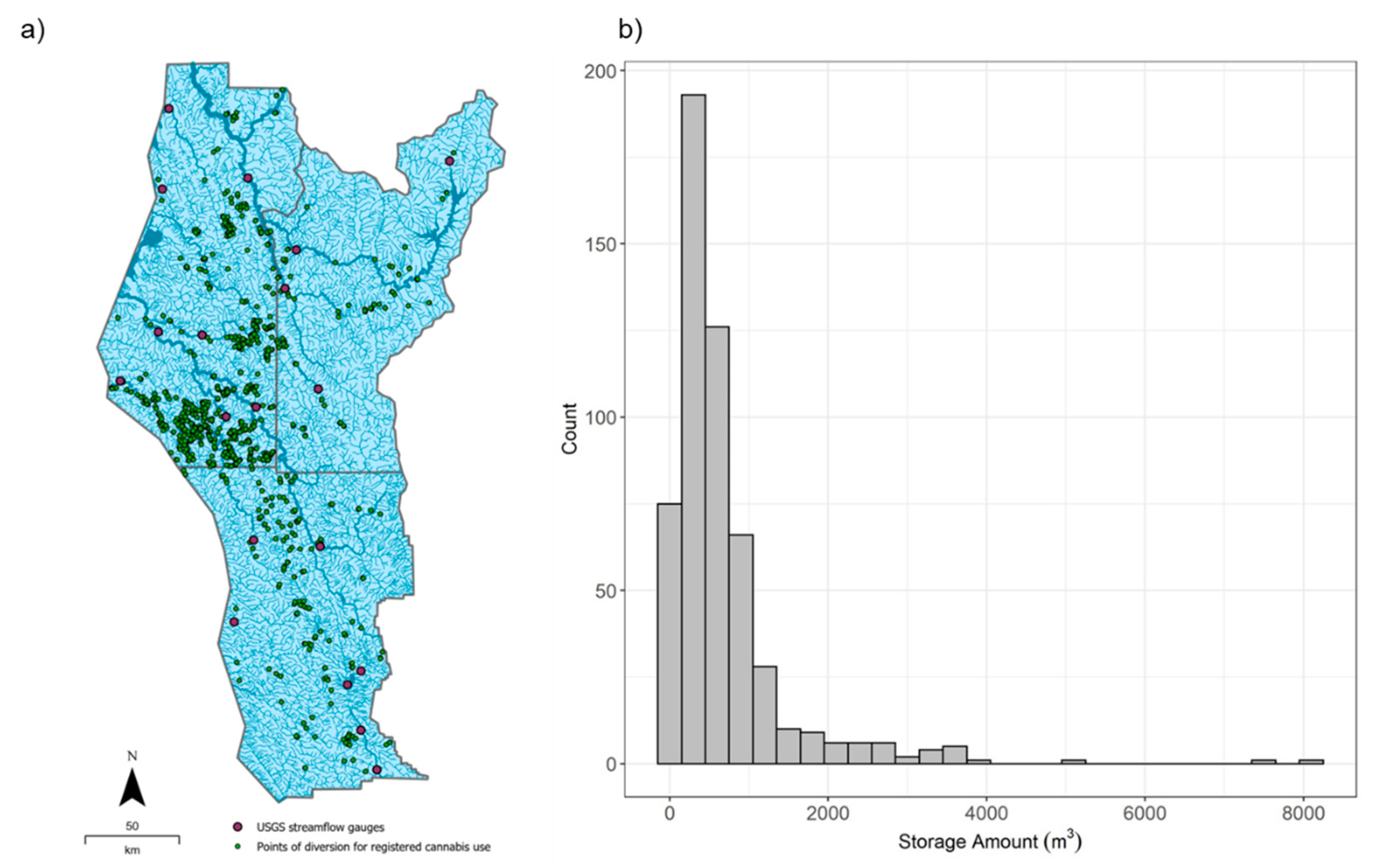
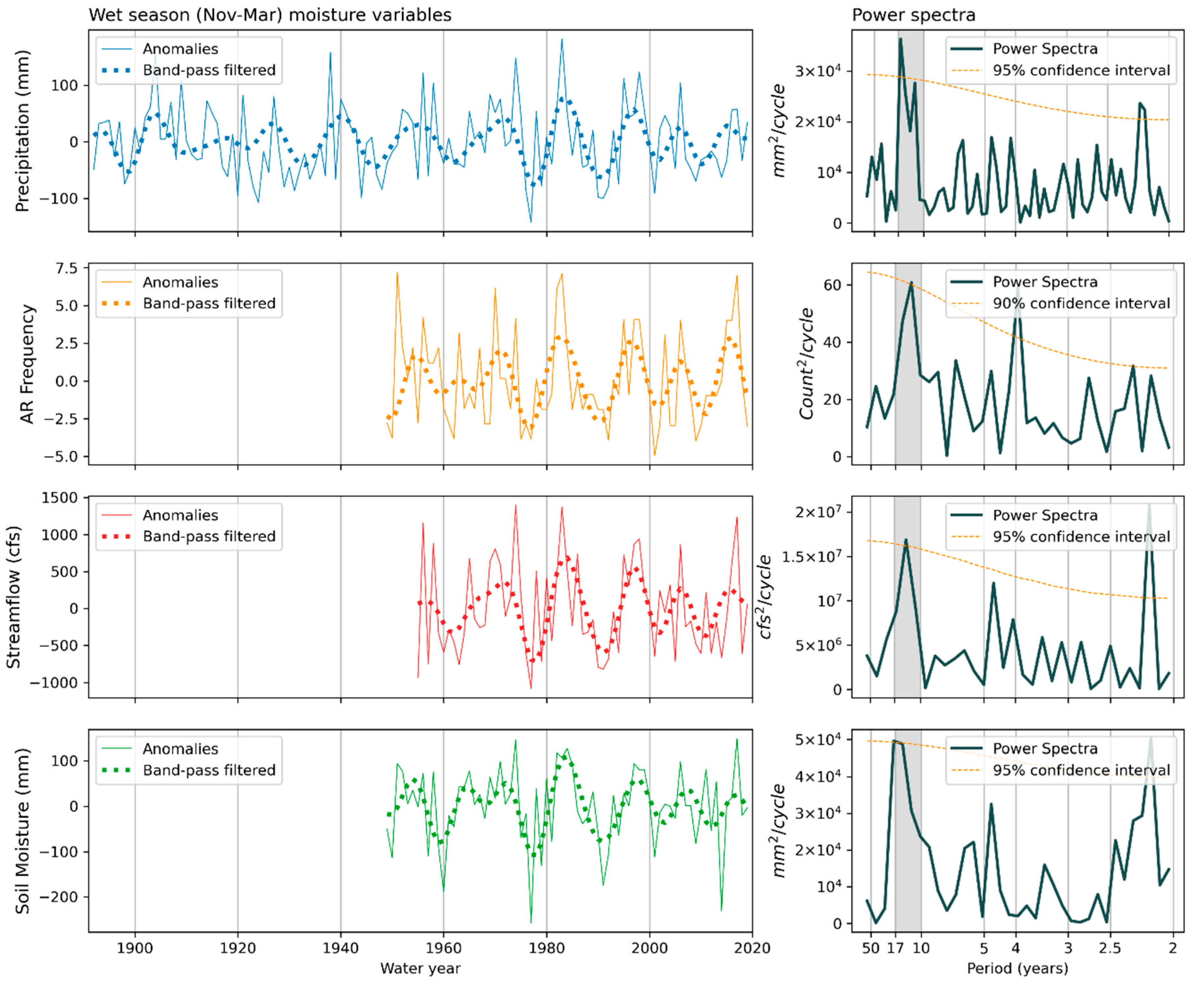
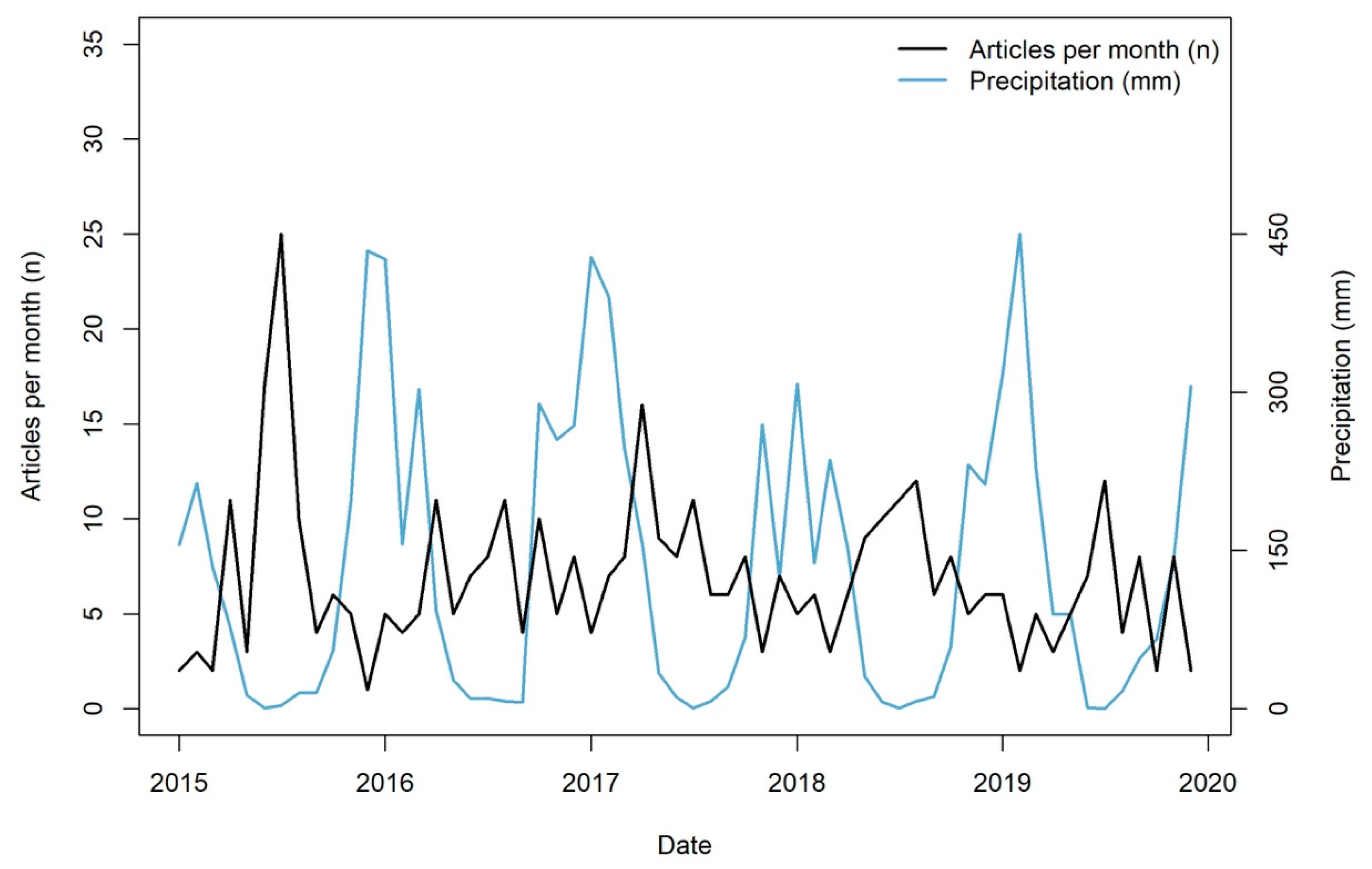
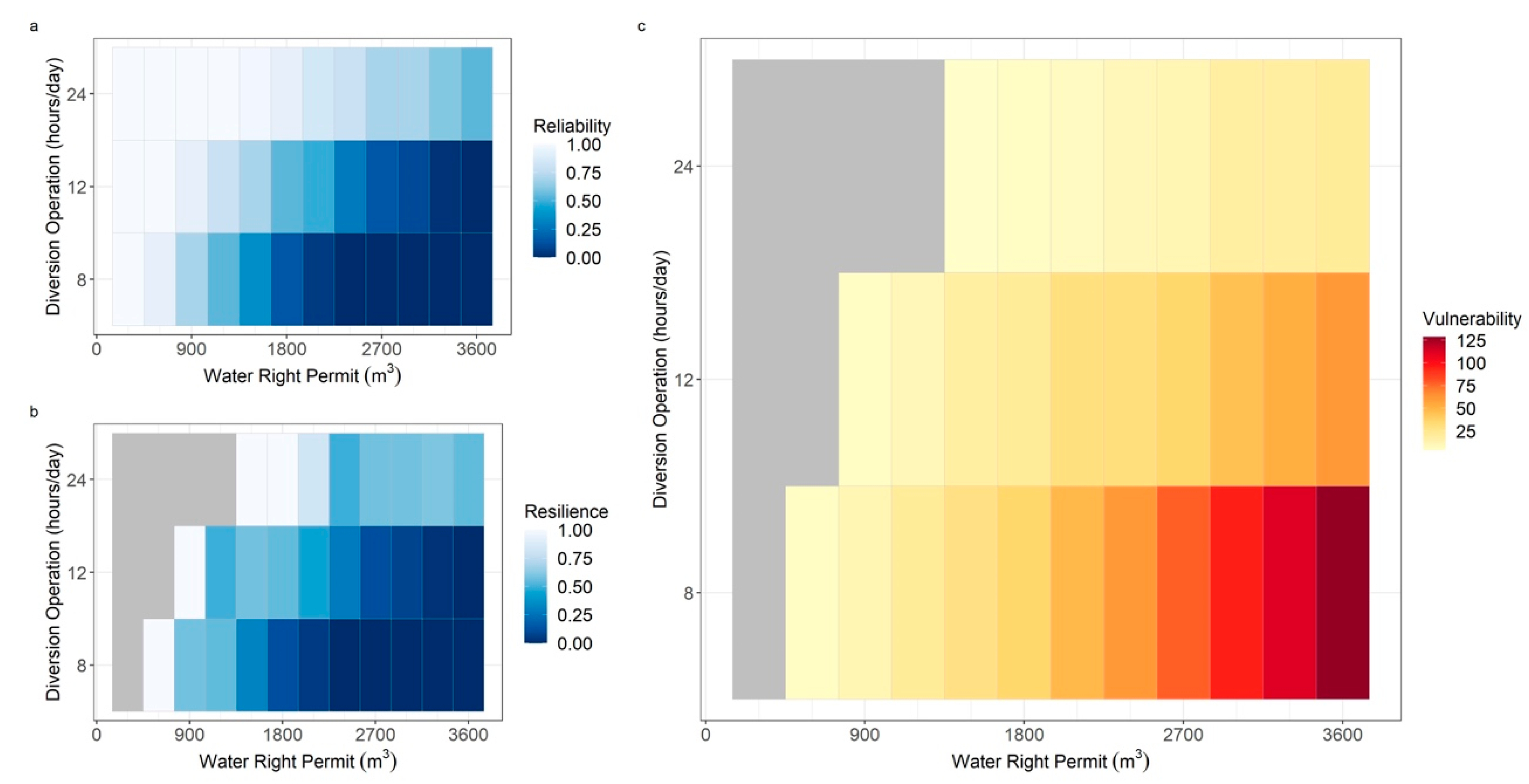
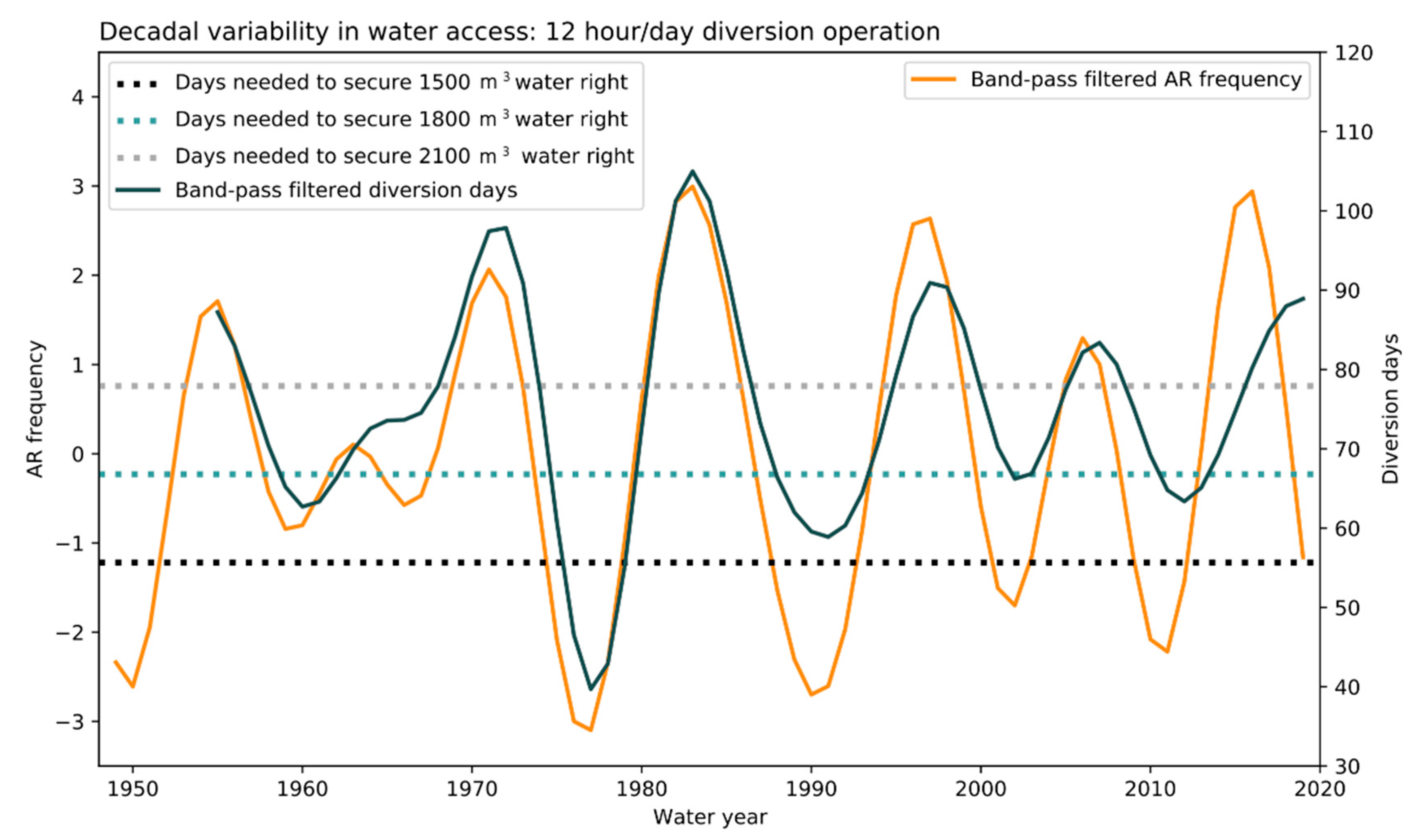
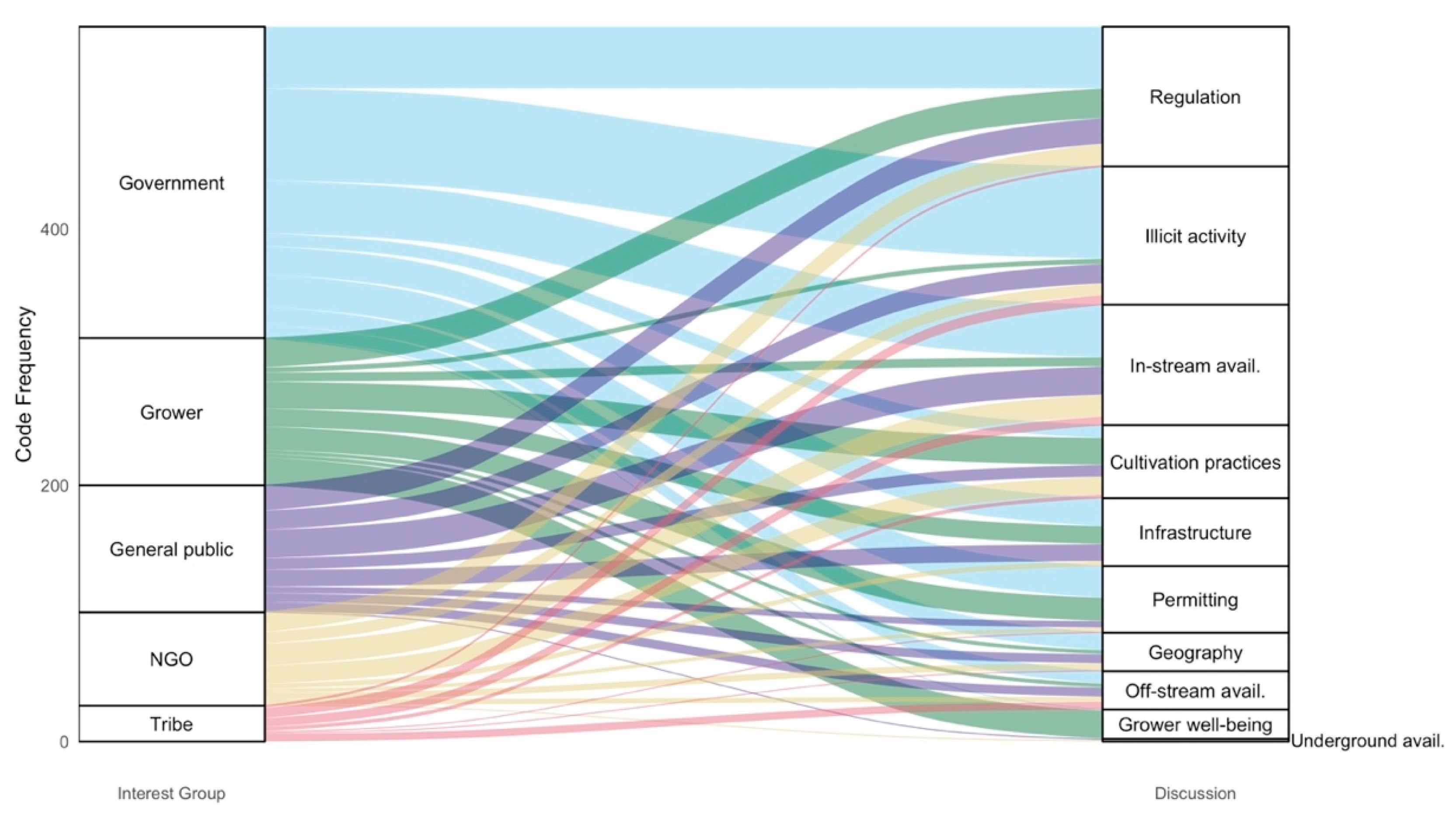
| Search Platform | Search Terms |
|---|---|
| Newspaper database | (California or “Emerald Triangle” or “Northern California” or Humboldt or Mendocino or Trinity) AND (cannabis or marijuana) AND (water or climate or weather or storm or rain or “atmospheric river” or irrig$ or diver$ or groundwater or river or stream or creek) |
| Newspaper archives | cannabis AND water |
| Category | Code | Definition |
|---|---|---|
| Climate | Climate and weather | Broad mentions of climate and weather, such as drought and rain |
| Climate change | Specific mentions of changes to or new patterns in climate/weather | |
| Policy | Regulation | References to the regulatory framework for cannabis water use |
| Permitting | Specific mentions of permitting, including cost, applications, etc. | |
| Water use | Cultivation practices | References to practices that affect cannabis water demand and use |
| Geography | References to the geographical location of cannabis water use | |
| Illicit activity | References to illicit cannabis water use | |
| Infrastructure | References to physical items for water access, storage, application | |
| Impact | Instream availability | Impact of cannabis water use on stream ecosystems |
| Off-stream availability | Impact of cannabis water use on other off-stream users | |
| Underground availability | Impact of cannabis water use on groundwater availability | |
| Grower well-being | Impact of cannabis water use on grower well-being, quality of life |
Publisher’s Note: MDPI stays neutral with regard to jurisdictional claims in published maps and institutional affiliations. |
© 2020 by the authors. Licensee MDPI, Basel, Switzerland. This article is an open access article distributed under the terms and conditions of the Creative Commons Attribution (CC BY) license (http://creativecommons.org/licenses/by/4.0/).
Share and Cite
Morgan, B.; Spangler, K.; Stuivenvolt Allen, J.; Morrisett, C.N.; Brunson, M.W.; Wang, S.-Y.S.; Huntly, N. Water Availability for Cannabis in Northern California: Intersections of Climate, Policy, and Public Discourse. Water 2021, 13, 5. https://doi.org/10.3390/w13010005
Morgan B, Spangler K, Stuivenvolt Allen J, Morrisett CN, Brunson MW, Wang S-YS, Huntly N. Water Availability for Cannabis in Northern California: Intersections of Climate, Policy, and Public Discourse. Water. 2021; 13(1):5. https://doi.org/10.3390/w13010005
Chicago/Turabian StyleMorgan, Betsy, Kaitlyn Spangler, Jacob Stuivenvolt Allen, Christina N. Morrisett, Mark W. Brunson, Shih-Yu Simon Wang, and Nancy Huntly. 2021. "Water Availability for Cannabis in Northern California: Intersections of Climate, Policy, and Public Discourse" Water 13, no. 1: 5. https://doi.org/10.3390/w13010005
APA StyleMorgan, B., Spangler, K., Stuivenvolt Allen, J., Morrisett, C. N., Brunson, M. W., Wang, S.-Y. S., & Huntly, N. (2021). Water Availability for Cannabis in Northern California: Intersections of Climate, Policy, and Public Discourse. Water, 13(1), 5. https://doi.org/10.3390/w13010005





